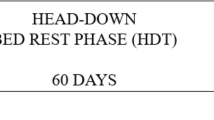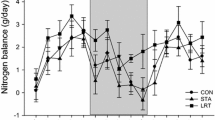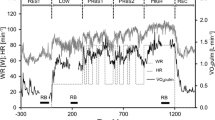Abstract
The effect of a 120-day 6° head-down tilt (HDT) bed rest with and without countermeasures on the mechanical properties of the human triceps surae muscle was studied in eight healthy young women subjects. One group [n = 4, mean age 31.5 (SEM 1.7) years] underwent a 120-day HDT only and a second group [n = 4; mean age 28.0 (SEM 1.1) years] underwent HDT with countermeasures (physical training). The results showed that the contractile properties of the skeletal muscle studied changed considerably. After HDT without countermeasures the maximal voluntary contraction (MVC) had decreased by 36% (P < 0.05), and the electrically evoked tetanic tension at 150 Hz (P o) and isometric twitch contraction (P t) had decreased by 24% (P < 0.02) and 12% (P < 0.05), respectively. Time- to-peak tension (TPT) of the twitch had significantly increased by 14% (P<0.05), but half-relaxation time (1/2RT), and total contraction time (TCT) had decreased by 19% (P<0.05) and 18% (P<0.05), respectively. The difference between P o and MVC expressed as a percentage of P o and referred to as force deficiency (FD), was also calculated. The FD had increased by 40% (P<0.001). The rate of increase of voluntary contractions calculated according to a relative scale had significantly reduced, but for the electrically evoked contraction no substantial changes were observed. After HDT with countermeasures TPT, 1/2RT and TCT of the twitch had decreased by 4%, 7%, 19%, respectively in relation to the control condition. Training had caused a decrease of 3% (P>0.05) in MVC, and P t, and in P o of 14%, and of 9% (P>0.05), respectively. The FD had decreased significantly by 10% (P<0.02). The rate of increase of electrically evoked tetanic tension did not change significantly during HDT with countermeasures but the rate of increase in isometric voluntary tension development was increased. Physical training provided a reserve of neuromuscular function, which attenuated the effect of bed rest. The experimental findings indicated that neural as well as muscle adaptation occurred in response to HDT with countermeasures.
Similar content being viewed by others
Author information
Authors and Affiliations
Additional information
Accepted: 7 November 1997
Rights and permissions
About this article
Cite this article
Koryak, Y. Effect of 120 days of bed-rest with and without countermeasures on the mechanical properties of the triceps surae muscle in young women. Eur J Appl Physiol 78, 128–135 (1998). https://doi.org/10.1007/s004210050397
Issue Date:
DOI: https://doi.org/10.1007/s004210050397




